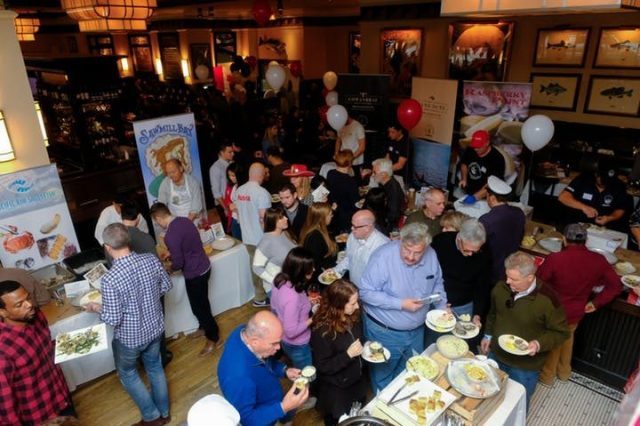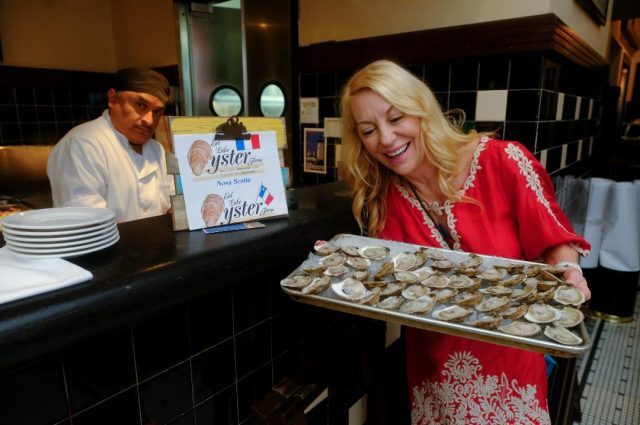
Docks All-Canadian Oyster Festival features lots of bivalves and a heated shucking competition
Docks Oyster Bar & Seafood Grill
633 Third Ave. at Fortieth St.
Saturday, November 23, $65-$125, 12:00 – 3:00
212-986-8080
docksoysterbar.com
“Before the twentieth century, when people thought of New York, they thought of oysters,” award-winning author Mark Kurlansky writes in the preface to his 2006 book The Big Oyster: History on the Half Shell. “This is what New York was to the world — a great oceangoing port where people ate succulent local oysters from their harbor. . . . Oysters were true New Yorkers.” So what is Docks Oyster Bar & Seafood Grill, a Murray Hill institution for four decades, doing hosting an All-Canadian Oyster Festival?
For more than fifteen years, Docks has been home to a fall and spring oyster festival, but last November, for the first time, it featured Canadian oysters exclusively, eighteen different varieties, in addition to holding a hotly contested shucking competition (with a $1,000 cash prize). The Canadian fest, which will also serve chowders and shrimp and includes live music by People vs. Larsen, returns November 23, with master Montreal-based oyster-shucking champion Daniel Notkin as MC and celebrity shucking judges Julie Qiu, oyster sommelier and founder of In a Half Shell, and chef Andrew Gruel, founder of Slapfish restaurants. Below is an edited, combined transcript of separate interviews I conducted with Notkin, Qiu, and Gruel as well as Docks executive chef Freda Sugarman and one of the event’s chief organizers, Emmy winner Michael-Ann Rowe, the Fishionista behind such shows as Off the Beaten Palate and Put Your Best Fish Forward.
twi-ny: When did you shuck your first oyster?
julie qiu: January 13, 2010 — my birthday, by chef Lawrence Edelman! I blogged about it before In a Half Shell existed. 😀
andrew gruel: Seventeen years old, working at Cook’s Lobster House on the lobster docks in Bailey’s Island, Maine. I shucked oysters and cherry stones all summer, suffering shellfish infection one after another from stabbing myself so many times.
twi-ny: What is the key to shucking an oyster?
ag: Don’t use muscle, take your time, breathe.
jq: It’s easy to learn, difficult to master. The key to shucking a good oyster is to use as little force as possible and to leave as little of a trace of blade as possible.
dn: We all shuck a bit differently depending on the area of North America and around the world. There are lots of ways to get into an oyster, but the key to opening an oyster is to get into that shell so that you’re not breaking it or causing it to crumble, separate that adductor muscle from the top of the shell, and that same adductor from the bottom and leave nothing behind. The oyster should be presented and opened as if it didn’t even know we were there — just like it was four seconds earlier locked in that shell.
twi-ny: What is the Shuckinhell list?
jq: Shuckinhell is a special category (and Instagram handle . . . not me) dedicated to the worst of the worst shucks that are paraded around as “good oysters.”
twi-ny: What’s the most common problem nonprofessionals have?
dn: There are a few! Getting into the hinge or into the shell I think is the hardest part. It can be very slight or very “tight” depending where you enter: If you go in through the “lip” (the slight opening where the top and bottom shells meet around the oyster) and that’s very tight, that can be tough. If you go in through the hinge (at the back where the shells are connected), that can be very small or very tight . . . and not having the right knife or one that’s too dull — that leads to a lot of problems and danger.
twi-ny: What is the greatest misconception New Yorkers have about oysters?
dn: Well, I actually think New Yorkers are doing great! New York was founded on oysters, and the resurgence and interest that New York and many cities have shown gives great joy and hope to all of us who care about ocean health and the preservation of our environment. Our good friends at the Billion Oyster Project in New York are just doing phenomenal work on educating young people about marine life and are making great strides with their efforts to repopulate the harbor and making it livable again for all species. No small task!
I think moreover that there’s just so much for them to learn about oysters that is fascinating. We addressed a lot of them in our documentary, Shuckers (that we hope to bring out on a platform soon), but they’re just amazing: Each single oyster filters fifty gallons of water a day (1M oysters = 50M gallons filtered!); that they don’t filter garbage or waste but rather algae and phytoplankton, which cloud up the waterways and if allowed to overpopulate cause red tide and death to all species; that they live in estuaries where the rivers meet the sea for just that reason; that they’re 650 million years old; that they’re one of the healthiest things you can eat on the planet; and that the more you eat them (these days) the more you’re saving the world!
Oysters used to be mostly wild but now they’re all farmed but have to be grown in natural waterways, so the more you eat oysters, the more money goes back to the farmers, the more we filter the water and replace the oysters that were once there, the more they have a greater appreciation and presence, and a greater voice to improve our oceans and water systems.
I think the only misconception is for those who choose not to eat oysters because they’re concerned about harming animals (i.e., vegans). Oysters have no central nervous system, no motility, no cognition, and likely the same bioreactionary traits we are now finding in lettuce and all plants and trees and all aspects of nature. All told, if you eat lettuce, you can feel okay, and even better eating an oyster.
twi-ny: Do New Yorkers really get into watching the competition, or are they too busy eating and drinking?
dn: Boy, can they get into it! When you get really good shuckers, it’s a great show. And you don’t have to sacrifice eating and drinking. Each round lasts about a minute and a half, so grab a drink, grab a lobster roll and a plate of oysters, and watch the show!
twi-ny: Why the switch to Canadian oysters from local fare?
freda sugarman: We felt that it was super important to showcase areas in Canada that produce incredible shellfish. I enjoy having a close connection with the farmers and love seeing their passion for their product.
twi-ny: What are some of the primary differences between Canadian oysters and oysters from, for example, the East Coast, the West Coast, and Japan?
jq: Wow, that’s a big question. Primary difference: Species. Environment. Growing methodologies. But that’s generally the differences between all oysters. Canadian oysters take a bit longer to mature than other oysters grown around the world. For that reason, some of them are petite in nature but have very complex and layered flavors.

Michael-Ann Rowe brings out the next tray of delectable bivalves at Docks oyster fest (photo courtesy Michael-Ann Rowe)
twi-ny: What’s so special about Canadian oysters?
dn: Well! First off, all oysters are special. To say one was more special than the other would be like choosing a favorite child — ideally not possible. But what distinguishes our maritime Canadian oysters is their perseverance in the face of long winters and harsh conditions. That means each of these beautiful oysters in the small but perfect size of ~2.5-3″ is that they take three to five years to get to that point. Which means they’ve weathered a number of storms, and the best and most hearty survive.
Compare this to a New England oyster, which takes one to one and a half years to grow to 2.5/3″, and a Gulf oyster, which takes one year to grow to four inches. Well . . . these little guys put in the work. You get a beautifully clean taste and fresh, crisp character — cold butter and the fresh, clean salt of remaining ocean water with hints of a rich vegetal stock indicative of the algae they ingest. Beautiful oysters all.
twi-ny: What are your personal favorite oysters?
jq: I’m an equal opportunity international oyster lover. Can we make this question about favorite Canadian oysters? If that’s the case, I’m a fan of Village Bays from New Brunswick, Kusshi from Deep Bay, BC, and Raspberry Points from PEI.
ag: I will happily indulge in every type of Canadian oyster.
twi-ny: Freda, you prepare oysters several ways at Docks. How do you prefer to eat them?
fs: A simple touch of lemon.
twi-ny: And to drink?
fs: Everything goes well with tequila!
twi-ny: Michael-Ann, you’ve traveled all around North and South America writing about food. Where have you had the best oysters?
michael-ann rowe: Atlantic Canada. Seriously. Second to that is the US: Wellfleet (East Coast), and a surprise in Alabama were Murder Point Oysters.
twi-ny: You were born in Canada and live both there and in New York. Are there differences in how New Yorkers and Canadians eat oysters?
m-ar: Not really. They either douse them with a blast of pickled horseradish or eat them the right way. . . .
twi-ny: Which would be?
m-ar: Naked.